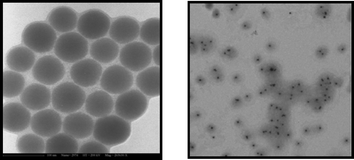Synthesis of poly(ε-caprolactone)–silica nanocomposites: from hairy colloids to core–shell nanoparticles
Abstract
The synthesis of structurally well defined poly(ε-caprolactone) (PCL)–silica nanocomposites was performed following two synthetic routes:( 1) “graft from” anionic ring opening polymerization of CL initiated from the surface of silica nanoparticles that have been previously modified by grafting of hydroxyl groups, and (2) dispersion polymerization of CL in the presence of OH-functionalized silica beads. In both strategies, yttrium or aluminium alkoxides were used as catalysts. In the first case, the influence of the catalyst, the OH to Al molar ratio and the monomer concentration on the amount of grafted polymer was studied. TEM analysis revealed the formation of a dense and uniform polymer brush around the silica nanoparticles. In the second case, “core–shell” particles with a silica core and a PCL shell were successfully obtained. The grafting of a small quantity of polymer on the silica surface during the first stages of the dispersion polymerization process appeared to be a prerequisite condition for encapsulation to succeed. When raw, un-modified silica beads were used, encapsulation failed to occur.


 Please wait while we load your content...
Please wait while we load your content...